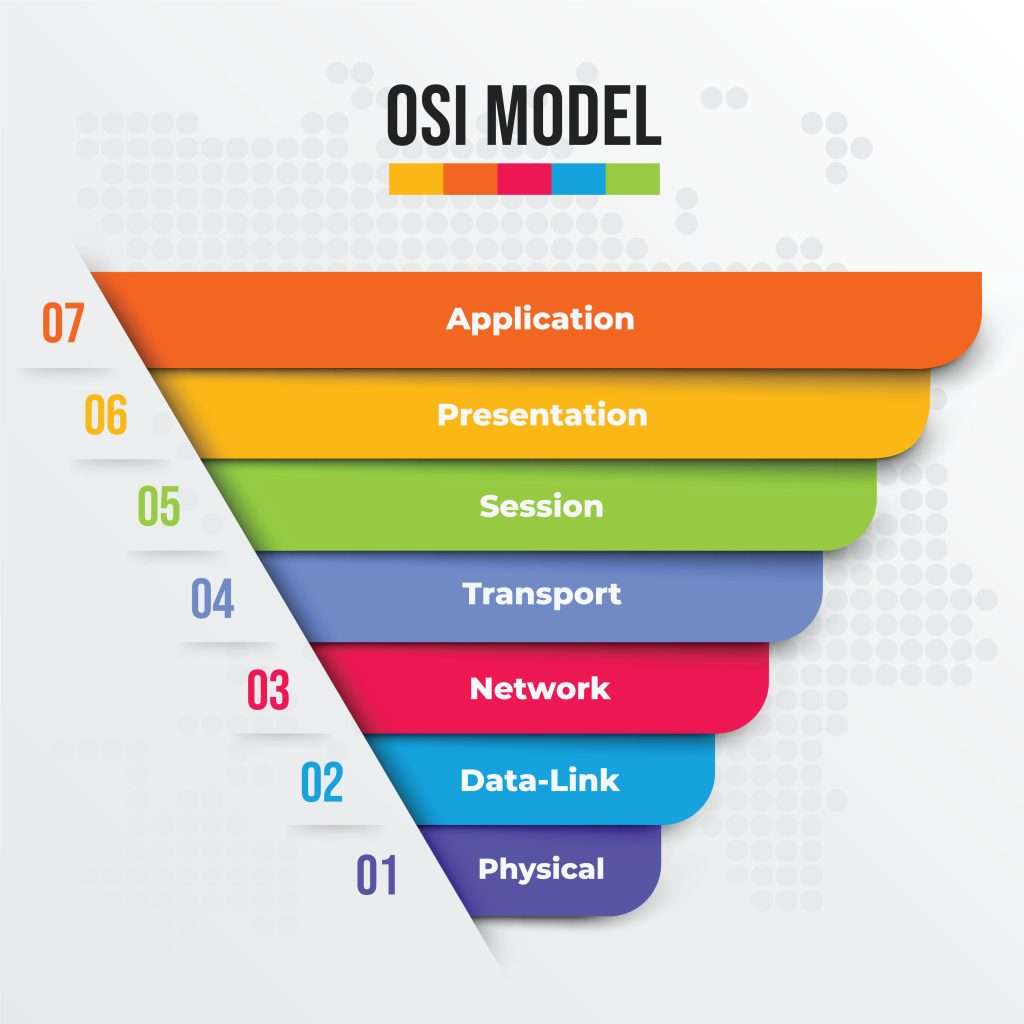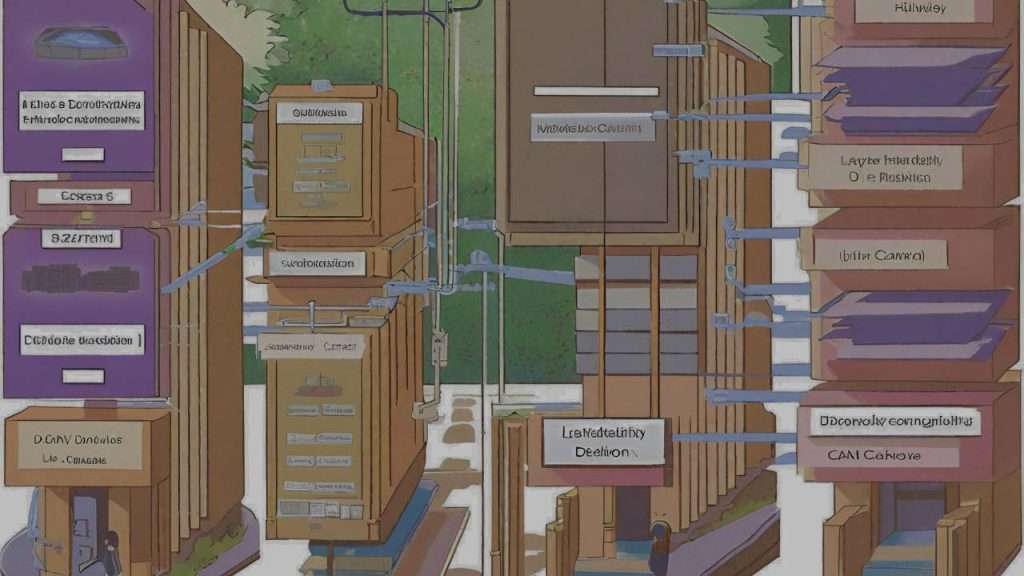In the realm of data networks and the vast expanse of the internet, the concept of layered architecture stands as a fundamental pillar. It not only provides a structured framework for network design but also facilitates scalability, interoperability, and ease of maintenance. In this comprehensive exploration, we delve deep into the significance of layered architecture in data networks and its relevance on the internet, the intricate layers of the OSI model, the interplay between hardware and software at various layers, and the diverse types of networks that form the backbone of modern connectivity.
Layered Architecture: A Conceptual Foundation
Layered architecture, also known as a layered model or protocol stack, embodies a systematic approach to organizing the functions and processes within a network. At its core, it entails the division of network functionality into distinct layers, each responsible for specific tasks and interactions with adjacent layers. This modular design fosters modularity, abstraction, and clarity in network implementations.
Why Layered Architecture in Data Networks/Internet?
Layered architecture finds its raison d’être in addressing the complexities inherent in data networks and the internet. By compartmentalizing network functionalities into discrete layers, it enables:
- Modularity and Abstraction: Layers operate independently, allowing for changes within one layer without affecting others, thereby promoting modular design and ease of maintenance.
- Interoperability: Clear interfaces between layers facilitate interoperability, enabling devices and systems from different vendors to communicate seamlessly.
- Standardization: Layered models, such as the OSI (Open Systems Interconnection) model, serve as standards for network design and implementation, fostering consistency and compatibility across diverse network environments.
- Debugging and Troubleshooting: The hierarchical nature of layered architecture simplifies the process of identifying and rectifying network issues by isolating problems to specific layers.
Overview of OSI Layer: Unraveling the Layers
The OSI model, conceived by the International Organization for Standardization (ISO), serves as a blueprint for network communication, delineating seven distinct layers, each with its unique features, functions, roles, and responsibilities.

1. Physical Layer
The Physical Layer represents the lowest layer of the OSI model, encompassing the transmission of raw data bits over the physical medium. Key features and functions include:
- Data Encoding: Conversion of digital data into signals suitable for transmission over the physical medium.
- Physical Topology: Defines the physical layout of network components and the medium used for transmission (e.g., copper, fiber optics).
- Bit Synchronization: Ensures synchronization of transmitting and receiving devices for accurate data transmission.
2. Data Link Layer
Situated above the Physical Layer, the Data Link Layer focuses on establishing and maintaining reliable point-to-point and point-to-multipoint connections. Key aspects include:
- Frame Synchronization: Delimitation of data into manageable frames for transmission.
- Error Detection and Correction: Mechanisms for detecting and recovering from errors occurring during transmission.
- MAC Addressing: Assigning unique addresses to network devices for identification and communication.
3. Network Layer
The Network Layer, positioned at an intermediate level, facilitates routing and forwarding of data packets across interconnected networks. Noteworthy features comprise:
- Logical Addressing: Assignment of logical addresses (e.g., IP addresses) to devices for network identification and addressing.
- Routing Protocols: Algorithms and mechanisms for determining optimal paths for packet delivery.
- Packet Switching: Forwarding of data packets from source to destination based on routing information.
4. Transport Layer
The Transport Layer assumes responsibility for end-to-end communication and ensures the reliable delivery of data between source and destination. Key functionalities include:
- Segmentation and Reassembly: Division of data into smaller segments for transmission and reassembly at the receiving end.
- Flow Control: Regulation of data transmission rates to prevent congestion and ensure efficient resource utilization.
- Error Recovery: Detection and retransmission of lost or corrupted data segments to guarantee data integrity.
5. Session Layer
Serving as the interface between applications and the lower OSI layers, the Session Layer manages and synchronizes communication sessions between devices. Notable attributes encompass:
- Session Establishment and Termination: Establishment, maintenance, and termination of communication sessions between network entities.
- Session Control: Coordination of data exchange sequences and session checkpoints for error recovery.
6. Presentation Layer
The Presentation Layer focuses on data representation, translation, and encryption to ensure compatibility and security across heterogeneous systems. Key functions include:
- Data Encryption and Decryption: Encryption of sensitive data for secure transmission and decryption at the receiving end.
- Data Compression: Compression techniques to optimize bandwidth utilization and expedite data transfer.
- Data Formatting: Conversion of data into standard formats for interoperability between disparate systems.
7. Application Layer
At the pinnacle of the OSI model, the Application Layer facilitates user interaction with network services and applications. Salient features comprise:
- Application Services: Provision of network services such as email, file transfer, and remote access.
- User Authentication: Verification of user credentials for secure access to network resources.
- Data Exchange Protocols: Implementation of standardized protocols for data exchange and interoperability.
Hardware and Software Approach in Different Layers
The implementation of layered architecture entails a harmonious interplay between hardware and software components across diverse OSI layers. While hardware components govern physical connectivity and data transmission, software elements orchestrate higher-layer functionalities and communication protocols.
Hardware Components

- Physical Layer: Hardware components include network interface cards (NICs), cables, switches, and routers responsible for transmitting raw data bits over physical media.
- Data Link Layer: Network switches operate at the Data Link Layer, facilitating the switching and routing of data frames between network segments.
- Network Layer: Routers serve as hardware devices operating at the Network Layer, responsible for packet forwarding and routing decisions based on destination IP addresses.
- Transport Layer: Hardware accelerators and offload engines optimize data transmission and enhance transport layer performance.
Software Components

- Transport Layer: TCP (Transmission Control Protocol) and UDP (User Datagram Protocol) are prominent transport layer protocols governing end-to-end communication and data delivery.
- Network Layer: IP (Internet Protocol) serves as the cornerstone of the Network Layer, providing logical addressing and routing capabilities for packet delivery.
- Application Layer: HTTP (Hypertext Transfer Protocol), SMTP (Simple Mail Transfer Protocol), FTP (File Transfer Protocol), and DNS (Domain Name System) are examples of application layer protocols facilitating various network services and applications.
The symbiotic relationship between hardware and software components ensures seamless communication and interoperability across the OSI layers, thereby enabling the efficient functioning of data networks and the internet.
Types of Networks: Navigating the Connectivity Landscape
Networks, in their diverse forms, underpin the global infrastructure of communication and information exchange. From Personal Area Networks (PANs) to Wide Area Networks (WANs), each network type serves distinct purposes and spans varying geographical scopes.
1. Personal Area Network (PAN)

A PAN encompasses interconnected devices within the immediate vicinity of an individual, typically within a range of a few meters. Key characteristics include:
- Bluetooth: Wireless technology enabling short-range communication between devices such as smartphones, laptops, and peripherals.
- Near Field Communication (NFC): Contactless communication technology facilitating data exchange between devices in close proximity.
2. Local Area Network (LAN)

LANs spans limited geographical areas such as homes, offices, or educational institutions, connecting devices within a confined space. Salient features comprise:
- Ethernet: Wired networking technology employing twisted-pair or fiber optic cables for high-speed data transmission within local networks.
- Wi-Fi (Wireless Fidelity): Wireless networking standard enabling connectivity between devices via radio frequencies, prevalent in homes and businesses.
3. Metropolitan Area Network (MAN)

MANs encompass larger geographical areas such as cities or municipalities, providing connectivity to diverse entities within a defined region. Noteworthy aspects include:
- Fiber Optic Networks: High-speed fiber optic links connecting various nodes and institutions within metropolitan regions.
- Municipal Wi-Fi Networks: Wireless infrastructure deployed by local authorities to offer internet access in public spaces and urban centers.
4. Wide Area Network (WAN)

WANs transcend geographical boundaries, linking disparate networks and locations across vast distances. Key characteristics include:
- Internet Backbone: Global network infrastructure comprising high-capacity links and routers facilitating intercontinental data exchange.
- Virtual Private Networks (VPNs): Secure tunnels over public networks, enabling private communication and remote access for businesses and organizations.
In conclusion, the layered architecture serves as the cornerstone of modern data networks and the internet, providing a structured framework for design, implementation, and interoperability. With a nuanced understanding of OSI layers, the interplay between hardware and software components, and the diverse typologies of networks, stakeholders can navigate the intricacies of network architecture and foster robust connectivity in the digital age.







